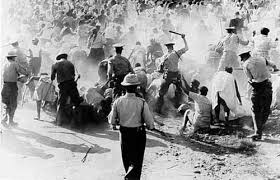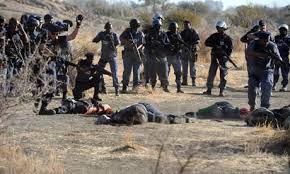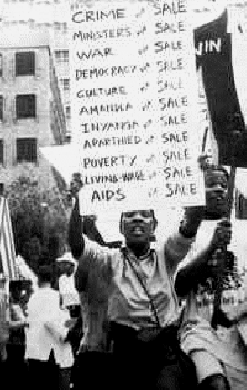Marikana 2012
“‘Do you believe’, she went on, ‘that the past dies?’
‘Yes’, said Margaret. ‘Yes, if the present cuts its throat.’”
– Leonora Carrington
The following is meant to provide a useful reference, through links, to all the texts and information concerning South Africa that are either on this site, or which I have found useful and interesting elsewhere. From time to time it may be updated.
List of texts on this site:
South Africa May 2013 – May 2016
south africa: street-sweepers “arrest” mayor…& MORE!!! (september 2015)
the third day of september (an eyewitness account of the Sebokeng Rebellion of 1984) by Johannes Rantete (put up on September 3rd 2014, written in September 1984)
south africa & some anarchist responses to mandela’s death (April 2014) Though this is perhaps too focused on 4 individuals’ responses to St.Nelson’s death, it also contains significant facts about South African, and ANC, history.
mandela can go to hell! (and “test taste”/”let us not mourn famous men”) (December 2013) A response to the almost overwhelming bullshit about Mandela.
south africa: another man done gone & post-marikana notes (2012-2013) About cop murders and various struggles in this period.
south africa – now & then (2005/1979/1983/1985) This covers many of the struggles in the period up to 2005, plus texts about S.A. in 1985, 1980 and the Black Consciousness movement from 1976 till 1979.
the class struggle in south africa 1976 – 80
soweto ’76 (1978/9) Lots of interesting details about the movement in 1976, though written from a white liberal point of view.
2.
A non-definitive list of other interesting texts:
The Durban Strikes 1973 (added to this list on 22/8/14)
turner – on the “ethics” of black consciousness (added to this list on 22/8/14)
movements in the platinum mines, 2009 – 2013
whiteout (2013) Though much of this is angry, vibrant, witty, genial rhetoric, which nevertheless remains rather over-general and abstract, it also contains some concrete facts about the Philippi squatters camp and other things going on in S.A. in 2013.
report on the farm workers struggles of 2012…and another report on the same struggle
marikana: a point of rupture? This, by insurgent notes, has some interesting facts – on a rather tame and tedious objective academic level – about SA, though it’s particularly tainted by some ridiculous appeal to the Left (rather than to proletarians), to get their politics straight, as if the Left in SA (as elsewhere) hadn’t consistently been part of the problem.
this day in prehistory (2012) A mixture of interesting reflections on some aspects of SA history and some stylistically poetic detours.
the big sell-out (1994) Good, though a bit repetitive, analysis of the ANC and Mandela by Dan Mokonyane, former member of a semi-Trotskyist grouping (which nevertheless never had the idea of becoming a political party) “The movement for a democracy of content”
on sexual abuse in the ANC camps (1993)
bounded revolt (chapter 4 of “Theatres of Struggle and the End of Apartheid”). Mainly about the “6 day war” in Alexandra at the beginning of their 6-month struggle in South Africa, 1986.“Old-style African Nationalism faded. A new kind of violence emerged…the young rebels reimagined Alexandra in bold and inventive ways…They reinvented “good” and “bad” spaces…They delineated private spaces such as homes and public spaces such as streets. They recast the meaning of official boundaries” (not sure when this was written, but its subject takes place in 1986)
an extract from “My traitors heart” by Rian Malan An extremely interesting (and often extraordinary) account of the daily life of mine workers (“There was no time or chance to prove yourself – who you are and what you want”) and their stuggle, both unionised and wildcat, in 1985-6.
the third day of september (an eyewitness account of the Sebokeng Rebellion of 1984) by Johannes Rantete “Can it be denied that the riots of Sebokeng were part and parcel of the fight for liberty by black South Africans? Although the motive was to strike against the rising rents, the course taken by the rebellion was so horrible that even the police could not withstand it. This I say because there was no roof of the business buildings that remained tall after the strikes except the well-planned Mphatlalatsane hall, Perm building and various churches. In Zone 11 all the shops were burnt down. The rent office, the bottlestore and the beerhall were burnt . Three houses were burnt One councillor was killed. Several cars were burnt, , including a brandnew Honda Ballade. The petrol station and the soft-drink cash-and-carry wholesale were also attacked. The roadhouse café was broken into and goods were taken away. Tarred and untarred roads in the zone were blocked with stones, boxes and anything else that was easy to carry. The Post Office was attacked and burned, not surprisingly. All the shops in Zone 12 were burnt down too . The rent office, the bottlestore, the beerhall, a doctor’s surgery and the house of a councillor were destroyed by fire. The tarred roads in thie zone were blocked with stones and pelted with bottles and burning objects to hamper the passing of cars – especially police vehicles. Zone 13, where there are more shops, was the first to come under attack. Not a single shop carried its original shape. Everything was in ashes. Here again the rent office was attacked, but the library and two clinics were spared. A house near the shopping centre was burnt. Roads used by buses were pelted with stones and broken bottles. Zone 14 is the undisputed CBD of Sebokeng. It carries public buildings and other large buildings which are not found in other zones . There is the well-known Mphatlalatsane hall, the Perm building, Texido Supermarket, the banks and building societies (Standard, Barclays, Volkskas, United, Allied) and the long frontage of the P & A Dryclearners building. Fire raged through all these buildings. All the shops – a “Hire a TV’ shop, a Kentucky, a beerhall, a bottlestore – were burnt….…The third of September has become a historic day. It saw the fulfilment of the forewarned strikes . . . Some of the victims of the strikes can be identified . . . Evaton’s deputy mayor Dutch Diphoko died in the Sebokeng hospital on Tuesday. Evaton’s mayor, Mr Sam Rabotapi, had to remain homeless after his house was burnt down. His gown was worn by an elderly woman who danced down the streets and called herself the first mayor . . . On Monday the Sharpeville councillor, Mr. Sam Dlamini, was killed by an angry mob. The boy Wisey Mnisi of Zone 12 was gunned to death.”
an extract from “Popular Struggles and Resistance movements in South Africa” Another very interesting account of the ultimately successful boycott movement against a flour, and flour-based products, manufacturing company (a struggle for the reinstatement of sacked workers), particularly interesting in how the division between coloureds and blacks was nurtured under apartheid and how they were broken down.
lessons of azikwelwa by dan mokonyane A very, perhaps overly, detailed but also very interesting account of the successful bus boycott of 1957 against the fare increases by one of its leading participants, which also shows how the ANC were amongst the first to want to sell-out the struggle. Also includes a brief history of South African capital from the late 19th century onwards. First published in 1979.
Brief resumé of aspects of the history of the Boers: “…Grievances the Boers held against the British started when British missionaries started to defend the rights of black Africans against the abuse by the Boers; that the “grievances” accelerated when the British outlawed slavery in Britain, and pushed against slavery in South Africa, eventually outlawing it there in 1834.
Dissatisfied with the compensation provided for emancipation, the Boers were positively outraged by the British determination that there should be equality between black and white, and embarked on their “Great Trek.” This rejection of racial equality is fundamental to the “Volk” identity of the Boer’s and their ideology as a “tribe” not a settler, colonizing formation. The rejection of racial equality was enshrined in the constitution of South Africa.
Secondly, I was referring to the historical role of the Boers as a social formation, as the word coming from the German for peasant but morphing to mean free farmers. The expulsion of black Africans from the land was first a precondition for the development of capitalism in South Africa, and became essential to its maintenance, providing a dispossessed labor force for rural and agricultural employment. That much of the Boer population moved into cities is part of that development, just as it is in every capitalist society. Nothing special about that; and nothing that shreds the legacy of Boer ideology and activity.
The power of the Boer ideology was predominant in South Africa, regardless of the numbers involved in actual farming; just as the ideology of the “happy, pre-Civil War South” was, and still is, dominant in the South. That ideology is white supremacy, and it reflects the very real material relations of the Boers to the black Africans.”
The story of a South African revolutionary (1992) (added 12/2/16)
Transition from below, Chapter 5 – “It was just chaotic” The apartheid workplace regime, political challenge and ‘ungovernability’ in the workplace. (added 12/2/16). 2 more chapters added on 20th July 2016: Strike committee at Witbank and Transition From Below Chapter 7
Added 15/8/16: Letter from Iranian Workers, an open letter of solidarity warning South African workers from having illusions in the ANC, and making comparisons with the situation in Iran at the tme of the 1979 revolution.
Added 16/2/17: INSIDE QUADRO, an article about mutiny in the “people´s army” of the ANC/CP and the torture-camps where dissidents were mutilated (some to death) with the latests methods learned from their sponsors (at that time) the USSR (United Stalinists for the Suppression of Revolution). It´s importance, among other things, lies in the link it makes between the formalised state (in-waiting)-terrorism of the ANC´s insecurity apparatus (convincingly described as an extension of the KGB in Africa) outside the borders of the country, and the informalised para-state terrorism inside South Africa during what is presented by the spectacle as a miraculously peaceful transition — the 18,000 killed in massacres and political violence during this period have literally been wiped out of the history books (the ones I remember reading at school in the New South Africa, in any case). [note by SK]



Leave a Reply